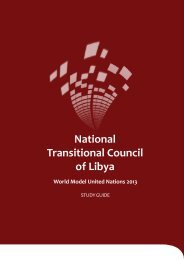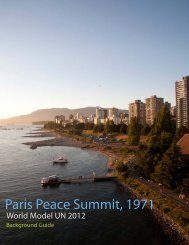Disarmament and International Security Committee (DISEC)World ...
Disarmament and International Security Committee (DISEC)World ...
Disarmament and International Security Committee (DISEC)World ...
You also want an ePaper? Increase the reach of your titles
YUMPU automatically turns print PDFs into web optimized ePapers that Google loves.
supportive of U.S. presence. 177<br />
Re-Emergent Russia<br />
After <strong>World</strong> War II, the Soviet Union used military<br />
bases as a way to counter the United States’<br />
containment policy. The Soviets tightened control<br />
over its satellite states <strong>and</strong> built military bases on<br />
their territories. Furthermore, they built bases to<br />
station troops in countries close to the u.S. <strong>and</strong><br />
its allies. The success of the Cuban Revolution in<br />
1959 brought a new ally into the Soviet’s sphere of<br />
influence. Soon afterward, the Soviets built a vast<br />
military infrastructure on the isl<strong>and</strong>. elsewhere<br />
in the developing world, the Soviets stationed<br />
military personnel in Angola, Egypt, Finl<strong>and</strong>, Guinea,<br />
Libya, Mongolia, Syria, Tunisia, Yemen, Yugoslavia,<br />
<strong>and</strong> Vietnam. 178 After the break-up of the Soviet<br />
Union, Russian troops withdrew from bases in East<br />
Germany, Czechoslovakia, Pol<strong>and</strong>, Hungary, <strong>and</strong> the<br />
Baltic states. By 1994, the Russian Federation had<br />
only 28 foreign bases in the former territory of the<br />
Soviet Union. By 2002, Russia had closed its military<br />
installations in Cuba <strong>and</strong> Vietnam. Domestic factors,<br />
budgetary constraints, <strong>and</strong> external politico-military<br />
reasons were behind this shift. 179<br />
Rising China<br />
In 2010, the Chinese government announced<br />
intentions of establishing military bases beyond its<br />
own borders, including in neighboring Pakistan. This<br />
was a significant move due to the implications for<br />
the balance of power within the region. A base in<br />
Pakistan would allow China to further counter India’s<br />
rising influence. At the same time, it could increase<br />
ties with Pakistan by offering military protection in<br />
the form of military bases. 180 Furthermore, the base<br />
would give the Chinese military another springboard<br />
from which it could quell separatist unrest in the<br />
Uighur-populated Xinjiang region. 181<br />
Until this century, China has no military bases<br />
outside its territory <strong>and</strong> has often criticized the United<br />
States for operating overseas bases. However, since<br />
the early 21st century, China has started building a<br />
number of commercial harbors, naval stations, <strong>and</strong><br />
listening posts that link the Sanya naval dockyard on<br />
Hainan Isl<strong>and</strong> to the Middle East. Beijing describes<br />
these facilities as the “String of Pearls” that dovetail<br />
Chinese energy supply routes to the Middle east <strong>and</strong><br />
east Africa. 182<br />
Europe<br />
From the mid-fifteenth to the mid-twentieth<br />
centuries, European nations have operated overseas<br />
military installations <strong>and</strong> trading posts. 183 Portugal<br />
<strong>and</strong> Spain were the first nations to do so. They<br />
built harbors <strong>and</strong> forts around the littorals of South<br />
America <strong>and</strong> West Africa during the 15th <strong>and</strong> 16th centuries to protect the burgeoning colonies of<br />
the time. The Netherl<strong>and</strong>s followed suit in the 17th centuries <strong>and</strong> erect military structures along its trade<br />
routes leading to Southeast Asia. From the 18th to the<br />
mid-20th century, France <strong>and</strong> the U.K. built military<br />
installations that linked their homel<strong>and</strong>s to the rest<br />
of their empires. 184 Currently, France <strong>and</strong> the United<br />
Kingdom still maintain a large number of overseas<br />
military installations in geopolitically sensitive<br />
regions such as the Middle east <strong>and</strong> northern Africa.<br />
Taken together, the number of European military<br />
installations is second only that of the u.S. 185<br />
The size <strong>and</strong> scope of these military installations vary<br />
greatly. in some locations, military facilities comprise<br />
of a few small buildings that are used as storage<br />
depots. At the other end of the spectrum, facilities<br />
could include barracks for hundreds of troops, large<br />
naval stations, or full-scale aerodromes. 186<br />
Past uN Actions<br />
Past United Nations Actions on the subject<br />
of foreign military bases has been limited. In 19<br />
December 1967, the 22nd Session of the uN General<br />
Assembly passed resolution 2344 regarding the<br />
elimination of foreign military bases in the countries<br />
37<br />
Melbourne Host Directorate PTY LTD | Office of Media <strong>and</strong> Design
















